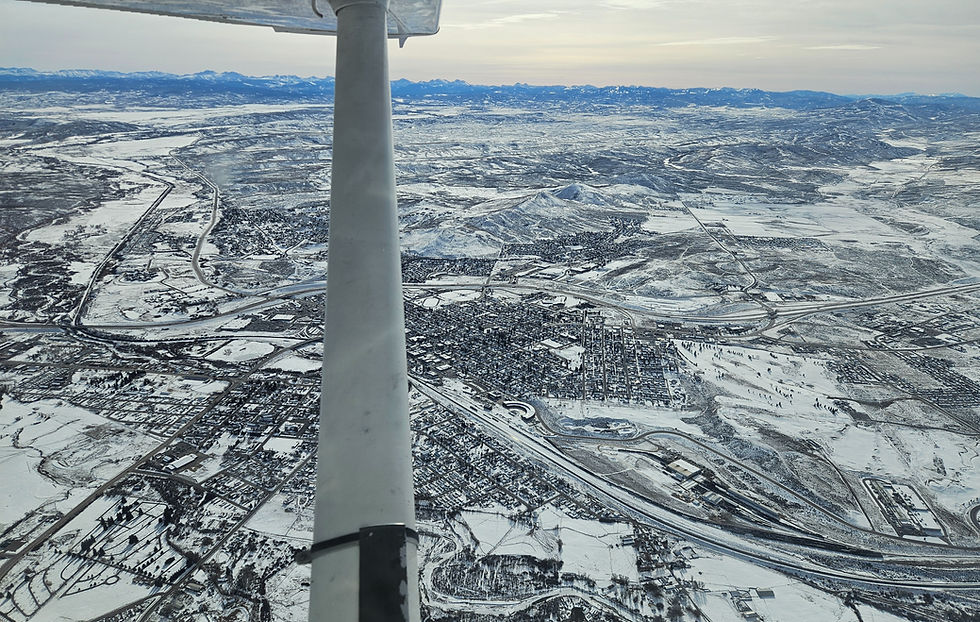Is Flying Better in the Summer or Winter?
- info
- Jan 2
- 3 min read

It is no small secret that weather has a big impact on aviation. So much so that before every flight pilots do a weather briefing to gain a thorough understanding of existing and forecasted weather making it one of the most integral parts of flight planning. To help pilots learn to interpret this data, we spend hours learning and studying weather theory alongside weather reports. From these practices, we know that weather at its core results from heat exchange. So how big of an impact does temperature have on flight performance and operations?
Effects of Temperature on Performance
Changes to the Outside Air Temperature (OAT) can result in substantial changes to aircraft performance. Any change in OAT will affect a current Density Altitude (DA) which in simple terms reflects the performance of an aircraft. Airplanes generally perform worse at higher altitudes than at lower ones. So if an airplane is flying at 6,000 feet Mean Sea Level (MSL) but the DA is 8,000 MSL, the airplane will perform below its standard performance as prescribed by the manufacturer. On the other hand, if the same plane is flying at 6,000 MSL but the DA is 4,000 MSL the plane will perform above standard. So how does temperature affect this?

The official definition of Density Altitude is Pressure Altitude corrected for non-standard temperature. Pressure Altitude is another conversation for a different article, but for today's purposes, all we need to know is that temperature changes will raise or lower DA. Other factors such as humidity also affect DA.
For example, a hot and humid day will see an increase in DA creating a High-Density Altitude (similar to densities found at high altitudes). Where a cold dry day will result in a decrease in DA allowing for flight at Low Density Altitudes (similar to altitudes found at low altitudes).

In the Summer months, pilots can expect to operate at a higher DA resulting in a decrease in power, lift, and thrust. Throughout the Winter months, pilots can expect the opposite. On cold dry Winter days, planes will typically perform at a lower DA and have an increase in power, lift, and thrust. With all of this said, it is clear that planes perform better on average in Wintertime, but does that mean that Winter is always the best time to fly?
Seasonal Effects on Flight Operations
Flight schools like Axiom Aviation tend to be far more limited when it comes to flight operations in adverse conditions than larger operators such as airlines. The main reason for this is a lack of deicing and anti-ice equipment for flight school planes. Without many of these advanced devices, flight schools are not able to safely fly in icing conditions. In colder states, this can greatly reduce the amount of time pilots can fly in the Winter.

During Summer months, icing is less of a concern, however, thunderstorms can still pose a serious threat to flight operations and extreme temperatures can reduce flight performance to dangerous levels. Axiom Aviation's fleet of High-Performance aircraft is less prohibited by high summer temperatures, but we still take every precaution necessary to ensure the safety of every flight which may result in limited cancellations.
So Which is Better, Flying in the Winter or Summer?
Different regions have different climates, for us here in Utah, Summer tends to be better for flight operations, but we typically find better performance in the Winter. While every year is different, a good example of how often students fly is that during the Summer months, if a student plans to fly 5 times per week and has no flexibility, meaning they can only fly during those 5 times, they will likely fly 4 of those flights. In the Winter the student would probably fly 3 of those flights. It should be noted that flexibility in a student's schedule will likely allow them to adapt to changing weather and fly more often.

The happy medium between Summer and Winter is of course Spring and Fall. Both of these seasons offer moderate weather with fewer extremes than Summer and Winter. Although Spring in Northern Utah is more prone to high winds than the Fall.
When should I start flight training?
Many prospective students ask us if they should wait until spring to begin flight training. There is no clear answer for all students, but we would say that the seasons should not be a deciding factor in when to start training. Particularly because Axioms Commercial Pilot Program takes around one year, enabling students to experience all four seasons while in training.
Have any questions about flight training? Reach out to us at (262)297-4568. Or email us at info@flyaxiom.com

Comments